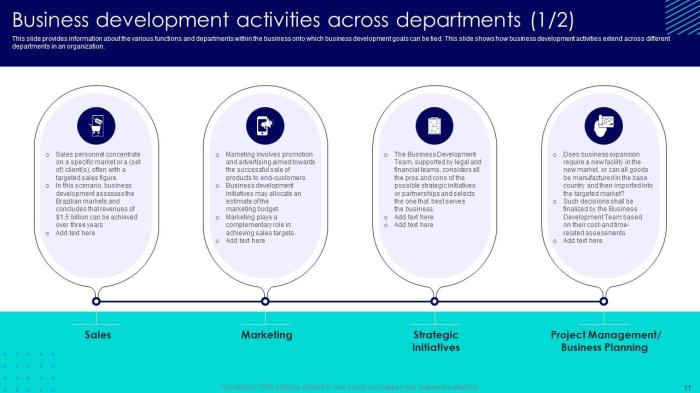
Effective business development hinges on a well-managed pipeline. Understanding how to cultivate leads, nurture relationships, and accurately forecast results is crucial for sustainable growth. This exploration delves into the core components of a robust business development pipeline, examining strategies for optimization, key performance indicators (KPIs), and the technology that facilitates success.
From lead generation and qualification to insightful data analysis and strategic decision-making, we’ll cover essential methodologies and tools. We will also explore the interplay between business development pipeline management and broader business strategies, including ethical considerations, coaching, and the impact of various business models.
Technology and Tools for Pipeline Management

Effective pipeline management relies heavily on the right technology and tools. Choosing the appropriate system can significantly impact sales team productivity, forecast accuracy, and overall revenue generation. This section explores various CRM systems and sales pipeline management software, highlighting their features and the benefits of automation.
CRM Systems for Pipeline Management: A Comparison
Different CRM systems offer varying levels of functionality for pipeline management. Some focus on basic contact management and deal tracking, while others provide advanced analytics and automation capabilities. For example, Salesforce is a robust platform known for its scalability and extensive features, making it suitable for large enterprises. However, its complexity can be a drawback for smaller businesses.
In contrast, HubSpot offers a more user-friendly interface and integrates seamlessly with other marketing tools, making it attractive to companies prioritizing marketing automation alongside sales pipeline management. Smaller, simpler CRMs like Zoho CRM cater to the needs of smaller businesses with more limited budgets and simpler sales processes. The optimal choice depends on the specific needs and size of the organization.
Features of Sales Pipeline Management Software
Effective sales pipeline management software typically includes several key features. These often encompass contact management, allowing for detailed tracking of interactions with potential clients; deal tracking, enabling the visualization of the sales process and progress of individual deals; reporting and analytics, providing insights into sales performance and identifying areas for improvement; forecasting capabilities, aiding in predicting future revenue; and automation features, such as automated email sequences and task reminders, to improve efficiency.
Furthermore, integration with other business tools, such as marketing automation platforms and communication channels, enhances the overall effectiveness of the system. Customizable dashboards and reporting tools allow for tailored monitoring of key performance indicators (KPIs).
Automation for Improved Pipeline Efficiency
Automation significantly enhances pipeline efficiency by streamlining repetitive tasks. For example, automated email sequences can nurture leads through the pipeline, providing valuable information and engaging prospects at the appropriate stages. Automated task assignments can ensure that sales representatives follow up on leads promptly, preventing opportunities from slipping through the cracks. Automated reporting can generate regular updates on pipeline performance, allowing managers to identify and address potential bottlenecks.
Consider a scenario where a company uses automated email reminders to follow up with prospects after a meeting. This simple automation ensures timely follow-up, increasing the likelihood of conversion and improving overall sales efficiency. Another example is the automated routing of leads based on pre-defined criteria, ensuring that the right sales representative contacts the right prospect at the right time.
Implementing a New Pipeline Management System: A Step-by-Step Guide
Implementing a new pipeline management system requires a structured approach. First, assess current processes and identify areas for improvement. This involves understanding the current sales cycle, identifying bottlenecks, and analyzing existing data. Second, select a suitable system based on the organization’s needs and budget. Third, configure the system to align with the sales process, including defining stages, fields, and workflows.
Fourth, train the sales team on the new system. Thorough training ensures adoption and maximizes the benefits of the system. Fifth, monitor performance and make adjustments as needed. Regular monitoring and analysis of key metrics will reveal areas requiring optimization, ensuring the system remains effective over time. Finally, ensure ongoing support and maintenance to address any issues and maintain system functionality.
Business Development and Related Concepts

Effective pipeline management is not merely about tracking leads; it’s intrinsically linked to broader business strategies and ethical considerations. Understanding these connections is crucial for sustainable growth and long-term success. This section explores the multifaceted relationship between pipeline management and various business concepts.
Business Ethics and Pipeline Management
Maintaining ethical standards is paramount in business development. A robust pipeline management system should incorporate ethical considerations at every stage, from lead generation to closing deals. For instance, employing deceptive marketing tactics to inflate the pipeline might yield short-term gains, but ultimately damages reputation and long-term prospects. Conversely, transparent communication and fair dealing build trust, fostering stronger client relationships and a healthier pipeline.
Ethical conduct ensures sustainable growth built on a foundation of integrity.
Business Coaching’s Impact on Pipeline Management
Business coaching provides invaluable support in enhancing pipeline management skills. Coaches offer personalized guidance, helping individuals identify weaknesses in their processes, develop effective strategies for lead qualification and nurturing, and improve sales conversion rates. Through targeted feedback and skill-building exercises, coaching can significantly improve an individual’s ability to manage their pipeline efficiently and effectively. For example, a coach might help a business owner refine their lead scoring system or implement a CRM to track progress more effectively.
Comparison of Business Development Strategies and Their Pipeline Impact
Different business development strategies directly influence pipeline composition and management. For instance, a focus on inbound marketing (e.g., content marketing, ) tends to create a steadier stream of qualified leads, leading to a more predictable pipeline. Conversely, outbound sales (e.g., cold calling, direct mail) can generate a more volatile pipeline, with peaks and troughs depending on campaign success.
A blended approach often offers the best balance, combining the predictability of inbound with the immediate results of outbound strategies. This diversified approach helps mitigate risk and ensure a consistent flow of opportunities.
The Role of Business Loans in Supporting Business Development Initiatives
Securing business loans can significantly bolster business development efforts. Loans can provide the necessary capital for activities such as hiring sales personnel, investing in marketing campaigns, or developing new products or services—all of which directly impact pipeline growth. For example, a small business might use a loan to invest in a CRM system, enabling better lead tracking and management, ultimately leading to a more efficient pipeline and improved sales conversion rates.
However, careful financial planning is crucial to ensure loan repayment doesn’t jeopardize the business’s overall health.
Business Model’s Influence on Pipeline Design and Strategy
The chosen business model fundamentally shapes the pipeline’s design and management strategy. A subscription-based business, for example, will require a pipeline focused on customer acquisition and retention, emphasizing recurring revenue. Conversely, a project-based business will need a pipeline focused on winning individual projects, requiring a different approach to lead qualification and opportunity management. The business model dictates the key performance indicators (KPIs) used to measure pipeline health and success.
Business Strategy’s Influence on Pipeline Management Decisions
Strategic business decisions directly influence pipeline management choices. For instance, a decision to expand into a new market will require adjustments to the pipeline, including identifying new target audiences, adapting sales messaging, and potentially hiring additional sales personnel. Similarly, a decision to prioritize a specific product or service line will necessitate a focus on generating leads relevant to that offering.
Strategic alignment ensures that pipeline management efforts support overall business objectives.
The Impact of Business Travel on Pipeline Development
Business travel can play a significant role in pipeline development, particularly in industries requiring face-to-face interactions. Attending industry conferences, trade shows, and client meetings can generate valuable leads and strengthen existing relationships, directly contributing to pipeline growth. However, careful planning and efficient time management are essential to maximize the return on investment in business travel. For example, pre-scheduling meetings with potential clients before attending a conference ensures the trip’s effectiveness in generating leads.
Mastering business development pipeline management is not merely about tracking leads; it’s about building a strategic engine for growth. By implementing the strategies, utilizing the appropriate technology, and consistently analyzing key performance indicators, businesses can transform their pipeline into a powerful driver of sustainable success. Continuous refinement and adaptation are key to maximizing the effectiveness of your pipeline and achieving ambitious business goals.
FAQ Compilation
What is the difference between a sales pipeline and a business development pipeline?
While often used interchangeably, a sales pipeline focuses on converting leads into sales, while a business development pipeline encompasses a broader range of activities, including lead generation, relationship building, and strategic partnerships, which may or may not directly result in immediate sales.
How often should I review and adjust my business development pipeline?
Regular review is crucial. Ideally, conduct a thorough review at least monthly, adjusting strategies based on performance data and market changes. More frequent monitoring (weekly or bi-weekly) may be necessary for rapidly evolving markets or new initiatives.
What are some common pitfalls to avoid in pipeline management?
Common pitfalls include neglecting lead nurturing, inaccurate forecasting due to poor data entry, failing to track KPIs, and not adapting to market changes. Over-reliance on a single lead source is another frequent mistake.






